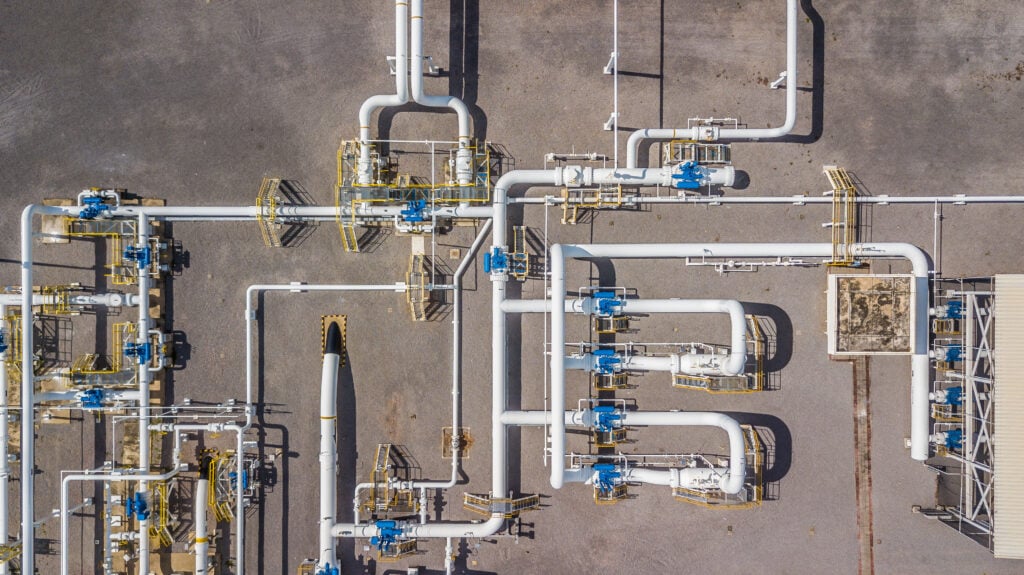Introduction
Natural gas has become a fundamental energy source in modern society. Its use ranges from the supply of energy for homes and companies to the generation of electricity in thermal power plants. However, to ensure that this resource reaches every corner, it is necessary to have an efficient and reliable infrastructure.
A gas pipeline is the backbone of the large-scale natural gas supply, allowing the safe and efficient transport of fuel from the fields to the final consumers, this energy source being a great alternative for an energy transition for sustainable development.
What is a pipeline and how does it work?
A gas pipeline is a linear infrastructure designed to transport natural gas from its source of production to the points of consumption. It is made up of high-strength steel pipes, which can be hundreds or even thousands of kilometers in length. These pipelines interconnect in an extensive network that spans regions, countries, and even continents.
The operation of a gas pipeline is relatively simple. Gas is extracted from reservoirs, where it is often associated with oil or trapped in underground geological formations. The gas is then purified and compressed for easy transportation. Once ready, it is injected into the pipeline at high pressure, which allows it to flow through the pipelines towards its final destination: The following image shows a Natural Gas Pipeline System.

The importance of the pipeline in the supply of natural gas
- Transportation efficiency: Pipelines are the most efficient way to transport large amounts of natural gas over long distances. Compared with other means of transportation, such as transportation by ship or tanker truck, gas pipelines have lower energy losses and higher carrying capacity.
- Reliability and safety: Gas pipelines are designed and built with high safety standards. They are equipped with advanced monitoring and control systems that make it possible to detect any anomaly and quickly respond to any emergency. This guarantees a constant and safe supply of natural gas to consumers.
- Emissions reduction: Natural gas is a cleaner energy source compared to traditional fossil fuels, such as coal or oil. Using pipelines to transport natural gas helps reduce greenhouse gas emissions and contributes to the fight against climate change.
- Facilitator of economic development: Pipelines allow natural gas to be brought to remote and less developed areas, which can boost economic growth and industrialization of those regions. Affordable and abundant natural gas can attract investment and create jobs in various industries.
- Regional and international integration : Gas pipelines are important in energy integration between countries and regions. They allow the exchange in the supply of natural gas between nations, strengthening commercial relations and economic cooperation.
Challenges and considerations
Although pipelines offer numerous benefits, they also face significant challenges and considerations:
- Significant Investments: The construction of a gas pipeline requires considerable investments in infrastructure and technology, which can pose a financial challenge for developers.
- Maintenance and safety: Adequate maintenance and operational safety are necessary to guarantee the reliable operation of the gas pipelines and with it the supply of natural gas. Leaks or ruptures can have serious consequences, so constant vigilance is essential.
- Environmental aspects: The construction of gas pipelines can affect the natural environment and local communities. It is necessary to carry out environmental impact assessments and commit to mitigating any negative effects from the supply of natural gas.
Conclusion
Pipelines are the backbone of large-scale natural gas supply, providing an efficient and safe infrastructure to transport this valuable resource from fields to end consumers. Its role in economic integration and sustainable development is undeniable, and as the demand for natural gas continues to grow, the expansion and modernization of gas pipeline networks will continue to be a key objective in the global energy future. However, it is essential to address the associated challenges, ensuring the sustainability and security of these important energy infrastructures.
References
- PREVENTION TRAINING. Everything you need to know about gas pipelines. Consulted on August 2, 2023; https://formacionprevencion.es/blog/todo-lo-que-necesitas-saber-sobre-los-gasoductos
- STRUCTURAL. How is the transportation of natural gas carried out?; Consulted on July 3, 2023; https://blog.structuralia.com/el-transporte-del-gas-natural
- PREVENTION TRAINING. Everything you need to know about gas pipelines. Consulted on August 2, 2023; https://formacionprevencion.es/blog/todo-lo-que-necesitas-saber-sobre-los-gasoductos
- CORDIS. Novel methods that increase safety and efficiency in oil and gas pipelines; Consulted on July 3, 2023; https://cordis.europa.eu/article/id/191178-novel-methods-for-safer-and-more-efficient-oil-and-natural-gas-pipelines/en

